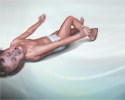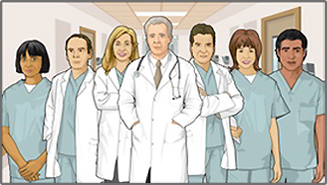Facial paralysis
Facial paralysis means that a person is no longer able to move some or all of the muscles on one or both sides of the face.
Causes
Facial paralysis is almost always caused by:
- Damage or swelling of the facial nerve, which carries signals from the brain to the muscles of the face
- Damage to the area of the brain that sends signals to the muscles of the face
- Weakness of the facial muscles that can occur in neurologic diseases such as myasthenia gravis or some myopathies and muscular dystrophies
Myasthenia gravis
Myasthenia gravis is a neuromuscular disorder. Neuromuscular disorders involve the muscles and the nerves that control them.
 ImageRead Article Now Book Mark Article
ImageRead Article Now Book Mark ArticleMuscular dystrophies
Muscular dystrophy (MD) is a group of inherited disorders that cause muscle weakness and loss of muscle tissue, which get worse over time.
 ImageRead Article Now Book Mark Article
ImageRead Article Now Book Mark Article
In people who are otherwise healthy, facial paralysis is often due to Bell palsy. This is a condition in which the facial nerve becomes inflamed.
Bell palsy
Bell palsy is a disorder of the nerve that controls movement of the muscles in the face. This nerve is called the facial or seventh cranial nerve. D...

Stroke may cause facial paralysis that comes on rapidly. With a stroke, other muscles on one side of the body may also be involved.
Stroke
A stroke occurs when blood flow to a part of the brain stops. A stroke is sometimes called a "brain attack. " If blood flow is cut off for longer th...

Facial paralysis that is due to a brain tumor usually develops slowly. Symptoms can include headaches, seizures, or hearing loss.
Seizures
A seizure is the physical changes in behavior that occurs during an episode of specific types of abnormal electrical activity in the brain. The term ...

In newborns, facial paralysis may be caused by trauma during birth.
Other causes include:
- Infection of the brain or surrounding tissues (such as HIV)
- Lyme disease
Lyme disease
Lyme disease is a bacterial infection that is spread through the bite of one of several types of ticks.
 ImageRead Article Now Book Mark Article
ImageRead Article Now Book Mark Article - Sarcoidosis
- Tumor that presses on the facial nerve
- Side effects of medicines, such as botulinum toxin
Home Care
Follow your health care provider's instructions on how to take care of yourself at home. Take any medicines as directed.
If the eye cannot fully close, the cornea must be protected from drying out with prescription eye drops or gel. An eye patch is sometimes required to protect the eye.
Physical and speech therapy can help preserve or restore function.
When to Contact a Medical Professional
Contact your provider if you have weakness or numbness in your face. Seek emergency medical help right away if you have these symptoms along with a severe headache, seizure, or blindness.
What to Expect at Your Office Visit
Your provider will perform a physical exam and ask questions about your medical history and symptoms, including:
- Are both sides of your face affected?
- Have you recently been sick or injured?
- What other symptoms do you have? For example, drooling, excessive tears from one eye, headaches, facial pain, seizures, vision problems, weakness, or paralysis.
Vision problems
There are many types of eye problems and vision disturbances, such as: Halos Blurred vision (the loss of sharpness of vision and the inability to see...
 ImageRead Article Now Book Mark Article
ImageRead Article Now Book Mark ArticleParalysis
Muscle function loss is when a muscle does not work or move normally. The medical term for complete loss of muscle function is paralysis.
 ImageRead Article Now Book Mark Article
ImageRead Article Now Book Mark Article
Tests that may be ordered include:
- Blood tests, including blood sugar, CBC, (ESR), Lyme test
- CT scan of the head
CT scan of the head
A head computed tomography (CT) scan uses many x-rays to create pictures of the head, including the skull, brain, eye sockets, and sinuses.
 ImageRead Article Now Book Mark Article
ImageRead Article Now Book Mark Article - Electromyography (EMG)
Electromyography
Electromyography (EMG) is a test that checks the health of the muscles and the nerves that control the muscles.
 ImageRead Article Now Book Mark Article
ImageRead Article Now Book Mark Article - MRI of the head
MRI of the head
A head MRI (magnetic resonance imaging) is an imaging test that uses powerful magnets and radio waves to create pictures of the brain and surrounding...
 ImageRead Article Now Book Mark Article
ImageRead Article Now Book Mark Article
Treatment depends on the cause. Follow your provider's treatment recommendations.
Your provider may refer you to a physical, speech, or occupational therapist. If facial paralysis from Bell palsy lasts for more than 6 to 12 months, surgery may be recommended to help the eye close and improve the appearance of the face.
Reviewed By
Joseph V. Campellone, MD, Department of Neurology, Cooper Medical School at Rowan University, Camden, NJ. Review provided by VeriMed Healthcare Network. Also reviewed by David C. Dugdale, MD, Medical Director, Brenda Conaway, Editorial Director, and the A.D.A.M. Editorial team.
Edje L. Acute facial paralysis. In: Kellerman RD, Heidelbaugh JJ, Lee EM, eds. Conn's Current Therapy 2025. Philadelphia, PA: Elsevier; 2025:763-766.
Mattox DE, Vivas EX. Clinical disorders of the facial nerve. In: Flint PW, Francis HW, Haughey BH, et al, eds. Cummings Otolaryngology: Head & Neck Surgery. 7th ed. Philadelphia, PA: Elsevier; 2021:chap 172.
Rucker JC, Seay MD. Cranial neuropathies. In: Jankovic J, Mazziotta JC, Pomeroy SL, Newman NJ, eds. Bradley and Daroff's Neurology in Clinical Practice. 8th ed. Philadelphia, PA: Elsevier; 2022:chap 103.
Smith AG, Shy ME. Peripheral neuropathies. In: Goldman L, Cooney KA, eds. Goldman-Cecil Medicine. 27th ed. Philadelphia, PA: Elsevier; 2024:chap 388.





